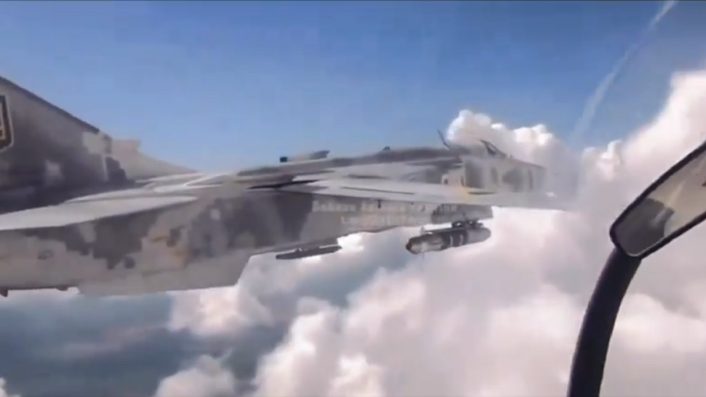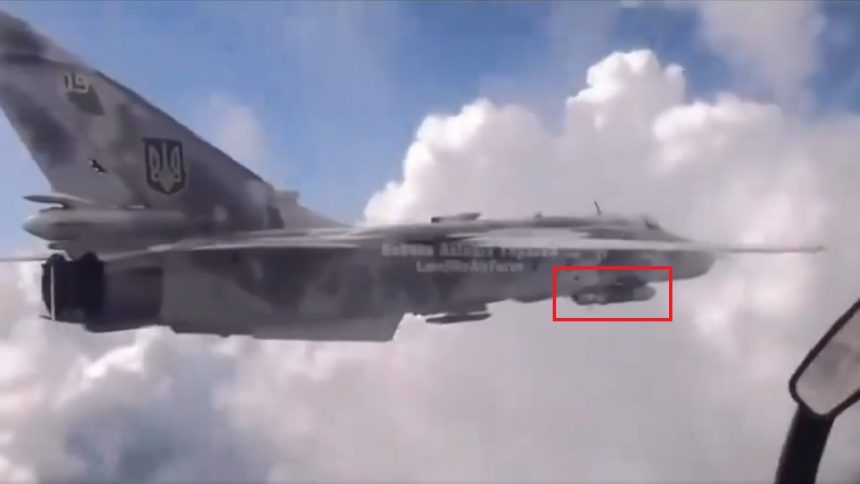Given the need for a large number of air-launched land-strike munitions and the limited supply of Western bombs like the GBU-39 SDB or AASM Hammer, Ukrainian defense industry may have come up with their version of a Russian UMPC glide bomb.
A Ukrainian Su-24 Fencer fighter-bomber has appeared in a video, carrying on its right underwing hardpoint what is claimed to be a new guided bomb. The video, posted by the ‘Colonel GSh/war_home’ Telegram channel and also shared on X, said the Su-24 is “testing” the Ukrainian analogue of the Russian UMPC (Universal Module for Planning and Correction) unit for converting drop bombs into guided units.
The author of the post claimed the Fencer was accompanied by a Su-27 fighter at the time, however it could not be seen in the video but it could be the aircraft from which the video was recorded. The post added that the photo suggests the unit has a small turbojet engine for propelling the bomb.
This however cannot be conclusively seen due to the grainy footage, but the possibility cannot be discarded either. Given the need for a large number of air-launched land-strike munitions and the limited supply of Western bombs like the GBU-39 SDB or AASM Hammer, it is possible Ukrainian defense industry may have come up with their version of a Russian UMPC.
It is also likely that the bomb may be designed to be capable of being employed from other aircraft in the UKrAF (Ukrainian Air Force) inventory, including the MiG-29, Su-27, the Su-25 or even the Western F-16s. This allows a diverse range of platforms to operate the bomb and not burden the Su-24s, which have largely been used to fire the Storm Shadow/SCALP-EG ALCM (Air-Launched Cruise Missile).
⚡🇺🇦💪💥A Ukrainian Air Force Su-24 front bomber with a new Ukrainian aerial bomb escorted by a Su-27. pic.twitter.com/mxoyWuWei5
— 🇺🇦 UkraineNewsLive🇺🇦 (@UkraineNewsLive) September 6, 2024
The new bomb
Russia’s UPMC-kitted bombs have had a devastating impact on Ukrainian tactical ground positions since last year, in persistent battlefield interdiction strikes being conducted by its Su-34 Fullback fighter bombers. The strikes continued even after Ukraine claimed to have shot down between 24 to 26 Fullbacks by late-2023 and claimed to have downed eight in Feb. 2024. Russia used FAB500, FAB1500 and the FAB3000 drop bombs kitted with the UMPC.
The video showed the new bomb being carried on the underwing hardpoint of the right wing with the ‘chase’ aircraft (claimed to be the Su-27) recording it from various angles. The bomb (or kit) appears to have a cruciform-shaped tail configuration with four fins. A small nozzle or exhaust can indeed be seen in the end, somewhat validating the presence of a motor for propulsion. The nose section might house the guidance section, perhaps a combined SATNAV (Satellite Navigation) and INS (Inertial Navigation System).
Whether it is an air-breathing powerplant cannot be ascertained since the grainy footage does not show any air inlets. It could therefore possibly be a rocket motor, like the one on the AASM Hammer guided glide bomb. The top part of the bomb where it is slung on the hardpoint reveals a long rectangular fairing, that could house the foldable wings that usually deploy after the munition is released. The test appears to be a carriage trial to validate the performance of the rack, launcher, fire control system, target cueing, and the electrical connections from the cockpit that release the bomb.

The UKrAF seems to have rapidly prototyped the unit and it would be reasonable to expect that it would be put into production soon. Whether Ukraine has the industrial capacity to mass manufacture such bombs is also in doubt. But an argument can be made that such a bomb conversion kit would not have been introduced if the UKrAF did not have the industrial capacity to churn out the bomb. But it is also not known whether both the bomb and kit have been developed together as a single unit.
Its manufacturing would also not leave a large industrial footprint for Russia to strike with standoff air-launched munitions. Indeed, Ukraine will have taken lessons from Western guided bombs like the AASM Hammer or the GBU-39 SDB into designing the bomb.
A segment from a newly released Russian MoD video showing one or more VKS Su-34 strike fighters releasing UMPK-equipped FAB-3000 M-54 bombs from the forward centerline station. The aircraft can also be seen carrying smaller UMPK-equipped bombs under the wings. pic.twitter.com/yFNuPQbxmM
— Guy Plopsky (@GuyPlopsky) July 14, 2024
Crucial need for ground strikes
Nevertheless, it does add diversity and tactical flexibility to its aerial ground attack roles. Such bombs usually have a minimum range of at least 50 km. A propulsion motor might add another 20 km, that can take the bomb to 70 km away. Videos on social media show the UKrAF largely using Storm Shadow ALCMs and rockets from pods from the Su-25 Frogfoot for ground attack missions.
Except for the Western guided bombs that have been photographed extensively in UKrAF sorties, it has so far not been seen domestically-made smart munitions. This might just be the first such weapon Kyiv has developed since the war. Kyiv Post quoted an earlier statement by UKrAF spokesperson Brig. Gen. Serhii Holubotsov who said in June that Ukraine “was in the process of developing its own guidance and range extension kit.” This “would transform its Soviet-era unguided bombs into precision munitions,” the report said.









